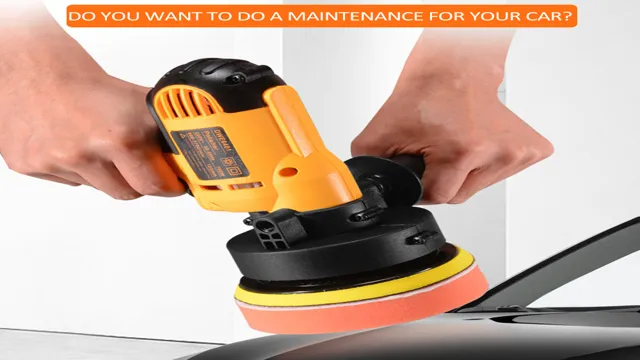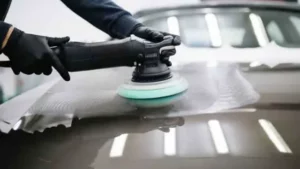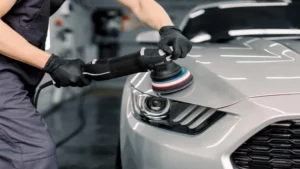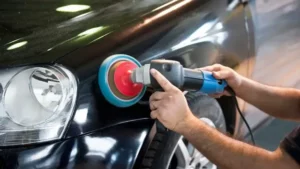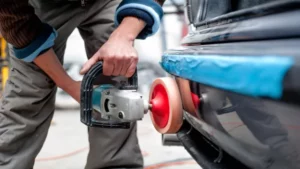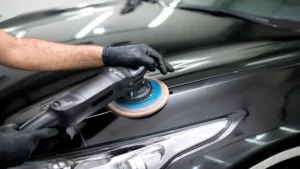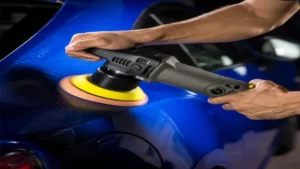Polishing your car can make a significant difference in its overall appearance. But, choosing the right size polisher can make or break your efforts. Using the wrong size can lead to uneven results and potentially damage your car’s paint.
This is why it’s important to understand what size polisher is best for the job. Think of it like choosing the right size paintbrush for a painting. You wouldn’t want to use a small brush on a large canvas or a large brush on a small canvas.
The same concept applies to polishing your car. So, how do you determine the right size polisher for your car? We’ll dive into the factors to consider and help you make an informed decision.
Understanding Polisher Sizes
“What size polisher for a car?” is a common question asked by DIY car enthusiasts. The size of the polisher is essential as it can affect the quality of the finish and the efficiency of the process. A small polisher usually around 3 to 4 inches in diameter is ideal for small or tight spaces and is useful for working on specific areas such as headlights.
A medium-sized polisher around 5 to 6 inches in diameter is perfect for general use and is an excellent choice for beginners. Meanwhile, a large polisher with up to 9 inches in diameter is suitable for extensive paint correction, but it requires experience and practice to handle well. Ultimately, the choice of polisher size depends on the job at hand and the user’s skills.
By assessing the needs of your vehicle and your abilities, you can confidently choose the right size polisher and achieve the desired results.
Different Types of Polisher Sizes
When it comes to selecting a polisher for your car or other surfaces, it’s important to understand the different sizes available. Polishers come in a variety of sizes, each with their own unique benefits. The most common polisher sizes are 6 inches, 5 inches, and 3 inches.
The larger the polisher, the faster it can work, but it can also be harder to control in smaller areas. The smaller the polisher, the easier it is to handle, but it may take longer to complete a job on a larger surface. So, when selecting a polisher, it’s important to consider the size of the area you’ll be working on, as well as the level of control you need.
Regardless of the size you choose, polishers are a great tool for achieving a professional-looking finish on your car or other surfaces.
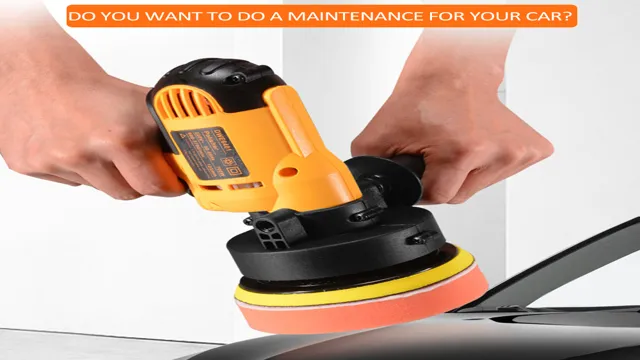
Factors to Consider When Choosing a Polisher Size
When it comes to choosing a polisher size, there are several factors to consider. The size of the polisher can impact your ability to reach tight spaces and perform detailed work effectively. It’s essential to understand the type of work you will be doing to determine the best size for your needs.
Larger polishers can cover more significant areas quickly, but they may not be as effective at handling intricate or detailed work. On the other hand, smaller polishers may be more precise, but they may not be as efficient for larger projects. Ultimately, your decision should be based on the specific tasks you will be performing and your personal preferences.
By taking the time to understand polisher sizes and how they impact your work, you can make an informed decision that will result in the best outcome for your project.
Determining the Size of Your Car
When it comes to choosing the right sized polisher for your car, there are a few things to consider. Firstly, the size of your car will play a big role in determining the size of polisher you need. If you have a small car like a hatchback or coupe, a smaller polisher will work just fine.
However, if you have a larger car like an SUV or pickup truck, you’ll need a bigger polisher to cover more surface area efficiently. It’s essential to keep in mind that using the wrong sized polisher can damage your car’s paintwork, so it’s better to err on the side of caution and choose a size that’s appropriate for your vehicle. Ultimately, the size of your polisher will depend on your car’s size – but there are other factors to consider too, such as the type of paint job on your car and the level of detailing you want to achieve.
With the right sized polisher, you can achieve a flawless finish that will leave your car looking like it’s just rolled off the showroom floor. So, what size polisher is right for your car? It all depends on your unique circumstances – but with a little research and trial and error, you’ll be able to find the perfect fit in no time.
Measuring Your Car’s Body
Measuring your car’s body can be an intimidating task, especially if you’re not familiar with your car’s dimensions. However, determining the size of your car is a necessary step if you plan on making any modifications or repairs. The best place to start is with the owner’s manual, which should provide you with the manufacturer’s specifications for the vehicle.
If you don’t have access to the manual, you can measure the car’s length, width, and height yourself. Measuring the length involves measuring the distance from the front bumper to the rear bumper, while measuring the width requires measuring the distance from one side of the car to the other. Lastly, measuring the height involves measuring the distance from the ground to the highest point of the car’s roof.
By taking accurate measurements, you’ll be able to confidently make modifications or repairs to your car without worrying about compatibility issues.
Considering the Shape and Contours of Your Car
When it comes to determining the size of your car, there are various factors to consider. The shape and contours of your car play a vital role in determining its overall size. You should take into account the length, width, and height of your car to ensure that it fits in your garage or parking space.
The bumper-to-bumper length of your car will give you an idea of how much space it will take up on the street or in a parking lot. It’s essential to keep in mind that larger cars have a higher risk of scrapes or dings when parking in tight spaces. Additionally, the contours of your car’s body will affect the amount of space it takes up visually.
Cars with a sleek, aerodynamic design may not appear too large, but they can take up considerable space on the road. Overall, it’s crucial to consider both the shape and size of your car to ensure that it fits your needs and lifestyle.
Matching the Polisher Size
When it comes to detailing your car, using a polisher can give it a professional, glossy finish. However, choosing the right size polisher is crucial to achieving optimal results. If you’re wondering what size polisher is best for your car, you’ll need to consider a few factors.
First, think about the size of your car. If you have a small vehicle, a six-inch polisher should be sufficient. For larger cars or SUVs, it’s recommended to use a seven or eight-inch polisher.
Additionally, consider your experience using a polisher. If you’re a beginner, starting with a smaller polisher may be easier to handle and get used to. Ultimately, matching the polisher size to your car’s size and your experience level will ensure the best outcome and a beautifully polished vehicle.
Choosing the Right Pad Size
Polishing your car is an essential task to keep it looking good and maintaining its value. However, choosing the right size of the pad for your polisher is just as important as selecting the right polish. Before you start, check the size of your polisher, as you will need a pad that matches its size.
Using a too-small pad can make it difficult to cover a lot of surface area quickly, whereas a pad that is too large may not be able to get into tight spaces. It’s like trying to wear a shoe that’s either too small or too big – it’s uncomfortable and doesn’t work. Therefore, select a pad that matches your polisher size to ensure maximum efficiency and an excellent finish.
Selecting the Appropriate Polishing Compound
Matching the right size of the polisher with your polishing compound is crucial to ensuring a successful polishing job. Using the wrong size of polisher can result in uneven and hazy finishes. Generally, the larger the surface area being polished, the larger the diameter of the polisher that should be used.
For example, if you are working on a larger surface area, such as a car hood, you may want to use a 7-inch polisher to cover more surface area in a shorter amount of time. However, if you are working on a smaller surface area, such as a headlight lens, a smaller polisher, like a 3-inch one, may be more appropriate. When in doubt, always start with a smaller polisher and work your way up to a larger one if necessary.
Matching your polisher size to your polishing compound will help you achieve a smooth and even finish for a professional-looking final result.
Conclusion
In the world of car polishing, size does matter. Finding the right size polisher for your car can make all the difference in achieving a flawless finish. Whether you’re a newbie or a pro, it’s important to consider the size and weight of your polisher in relation to the size of your vehicle.
Because as we all know, when it comes to car polishing, a little bit of power goes a long way!”
FAQs
What size polisher should I use for my car?
The size of the polisher you should use depends on the size of your car. For small cars, a 6-inch polisher may work well, but for larger vehicles, a 7-inch or 8-inch polisher may be more effective.
Can I use a rotary polisher for my car?
While rotary polishers can be effective for removing deep scratches and heavy swirl marks, they can also cause damage to the paint if not used properly. It is recommended to use a dual-action polisher for beginners to avoid any accidents.
Should I use a foam pad or wool pad for polishing my car?
Foam pads are generally safer to use as they are less abrasive and won’t cause as much damage to your paint. However, wool pads can be more effective for removing deep scratches, but require more experience to use properly.
How often should I polish my car?
It is recommended to polish your car every 6 months to a year, depending on the condition of your paint and your driving habits.
Can I use a household drill as a buffer for my car?
While it may be tempting to use a household drill as a makeshift buffer, it is not recommended. Household drills are not designed for the high speed and pressure required for polishing cars, and can cause damage to your paint.
Should I wax my car after polishing it?
Yes, it is recommended to wax your car after polishing it to protect the newly polished surface and add a layer of shine.
Can I use a metal polish on my car’s paint?
No, metal polish is not intended for use on car paint and can cause damage to the surface. Only use products specifically designed for car paint on your vehicle.
